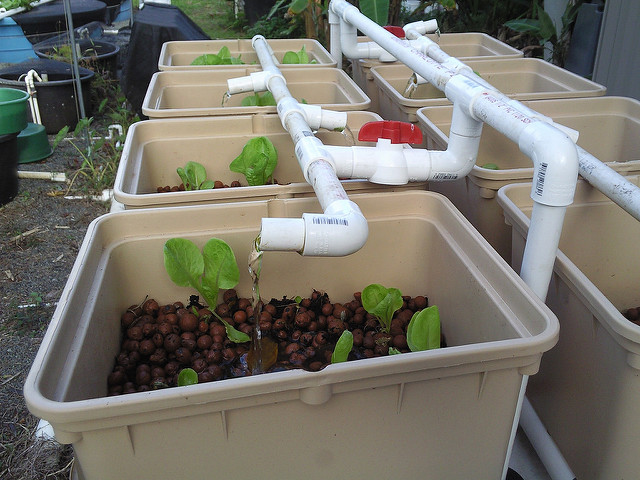This is Page 6 of our eight page series on hydroponic flood and drain systems. Click any of the links below to jump to that page.
Page 1 Page 2 Page 3 Page 4 Page 5 Page 6 Page 7 Page 8
Flood and Drain Systems, continued

A homemade system using deep plastic tubs as flood and drain containers, combined with PVC tubing and joints to deliver the nutrient solution. Note that the tubs are half-filled with hydroton as a growing medium. These young lettuce plants will have plenty of root depth while also having some protection from wind thanks to the tub walls. Also note that each side of the irrigation system has a separate valve which can turn that side on or off. This allows half the system to be in operation while the other half is down for harvesting, replanting or maintenance. When designing your own system, include a variety of shutoff points like this to help make maintenance easier.
Do It Yourself Potential
Flood and drain systems are very easy to build, even for hydroponic or construction rookies. The most demanding part of the entire system will be sizing the pipe which delivers nutrient solution between the reservoir and container. A general rule of thumb is to make the drain pipe or tube 1.25 times as big as the pipe or tube which delivers nutrient solution from the reservoir to the container. This is to help prevent accidental flooding of the container during any given irrigation cycle. In other words, the water can leave the reservoir slightly faster than it can come in.
An alternative is to use a bell siphon for your drain, and/or a float valve to regulate water flow into the container. Both of these introduce additional complexity to the system but provide some protection against overflow in the process. If you are comfortable expanding your knowledge able either of these topics, they can make your system a lot more resistant to accidents.
As part of our overall website services, we will eventually offer individual plans for various hydroponic systems. In the meantime, you can find various plans, either for free or for a small cost, at a variety of locations on the web. Simply search on "flood and drain plans" or "ebb and flow plans". If cost is an issue, include the word "free" in that search, but be aware that free materials are often questionable in quality. We do not want to advocate any such systems quite yet, at least not until we can evaluate them and determine if their materials and specifications provide real-world high performance. As we expand the website over time, we'll add well-researched and well-thought out designs and resources.
Scalability
Scalability in this context is a measure of how easily the system can be either increased or decreased in size over time. For instance, if the first ebb and flow system performs really well, you may want to expand. Or if situations change, you may need to scale back your operation. How easy is that to do with flood and drain systems?
Again, this is a qualitative measure, but flood and drain systems are fairly easy to scale up or scale down. If the quantity of plants needs to be reduced by only a small percentage, the same container and reservoir can be used and the container can simply be planted to a lower density. If large reductions are needed, the container can actually be subdivided by some kind of waterproof barrier, such that only a smaller portion will be planted and irrigated.
To scale up, the size of the reservoir will become an issue. If the reservoir was originally sized to match the container, then another reservoir will be needed to provide for another container. That setup can be repeated a few times without much loss of cost effectiveness. However, if a small system is going to be upgraded to a much larger system, for instance you now want 4 or 5 growing containers rather than just one, then the economies of scale dictate you at least consider getting a new bulk reservoir to feed a set of containers, rather than having one small reservoir per container. This would involve more complicated irrigation plumbing, while saving money with a single larger pump. Pencil out both options and see which one is more cost effective.
One very good practice is to try to anticipate your needs not only for this growing season, but for the seasons to come. For instance, if you haven't worked with flood and drain systems before and you want to start small, but you know you'll probably scale up fairly quickly, then it might be worthwhile to get a much bigger reservoir and pump than what you initially need. You can fill the reservoir only as high as needed to provide for a single container, and your oversized pump will be very comfortable moving smaller quantities at first. Then as you gain experience and get ready to expand the system, you can simply plug in new containers and fill the reservoir as high as needed. Your pump will already be sized for the job and it will just keep humming along. In this instance, be sure to consider your final plumbing arrangement so that you don't end up rebuilding your plumbing for the expansion.
Click any of the pages below to jump to that page